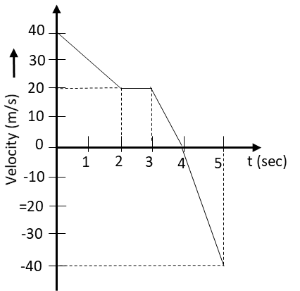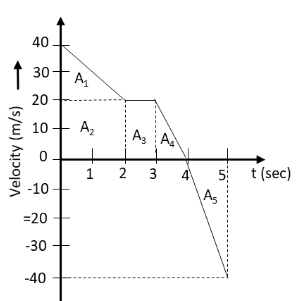
In the following velocity time graph of a body the distance traveled by the body and its displacement during 5 seconds in meter will be

A. $75, 75$
B. $110, 70$
C. $110, 110$
D. $110, 40$

Answer
556.8k+ views
Hint:Determine the total area under the curve. The area under the velocity time graph of an object gives the displacement of the object. But the total sum of the area above and under the time axis or x-axis gives the total distance traveled by the object and the resultant of the sum of area above the time axis and difference of area below the time axis gives displacement of the object.
Complete step by step answer:
We know that the distance traveled by the body can be determined by taking the sum of the total area under the velocity time graph of the body. Let us name the areas under the above velocity time graph as follows:

Hence, the total distance traveled by the body in 5 seconds is the sum of the 5 areas under the given velocity time graph of the body.
\[{\text{Distance}} = {A_1} + {A_2} + {A_3} + {A_4} + {A_5}\]
\[ \Rightarrow {\text{Distance}} = \left( {\dfrac{1}{2} \times 2\,{\text{s}} \times 20\,{\text{m/s}}} \right) + \left( {20\,{\text{m/s}} \times 2\,{\text{s}}} \right) + \left( {20\,{\text{m/s}} \times 1\,{\text{s}}} \right) + \left( {\dfrac{1}{2} \times 1\,{\text{s}} \times 20\,{\text{m/s}}} \right) + \left( {\dfrac{1}{2} \times 1\,{\text{s}} \times 40\,{\text{m/s}}} \right)\]
\[ \Rightarrow {\text{Distance}} = \left( {20\,{\text{m}}} \right) + \left( {40\,{\text{m}}} \right) + \left( {20\,{\text{m}}} \right) + \left( {10\,{\text{m}}} \right) + \left( {20\,{\text{m}}} \right)\]
\[ \therefore {\text{Distance}} = 110\,{\text{m}}\]
Therefore, the distance traveled by the body in 5 seconds is \[110\,{\text{m}}\].
The displacement of a body is the positive sum of the areas above the X-axis and negative sum of the areas under the x-axis of the velocity time graph of the body. Hence, the displacement of the body in 5 seconds is
\[{\text{Displacement}} = {A_1} + {A_2} + {A_3} + {A_4} - {A_5}\]
\[ \Rightarrow {\text{Displacement}} = \left( {\dfrac{1}{2} \times 2\,{\text{s}} \times 20\,{\text{m/s}}} \right) + \left( {20\,{\text{m/s}} \times 2\,{\text{s}}} \right) + \left( {20\,{\text{m/s}} \times 1\,{\text{s}}} \right) + \left( {\dfrac{1}{2} \times 1\,{\text{s}} \times 20\,{\text{m/s}}} \right) - \left( {\dfrac{1}{2} \times 1\,{\text{s}} \times 40\,{\text{m/s}}} \right)\]
\[ \Rightarrow {\text{Displacement}} = \left( {20\,{\text{m}}} \right) + \left( {40\,{\text{m}}} \right) + \left( {20\,{\text{m}}} \right) + \left( {10\,{\text{m}}} \right) - \left( {20\,{\text{m}}} \right)\]
\[ \therefore {\text{Displacement}} = 70\,{\text{m}}\]
Therefore, the displacement of the body in 5 seconds is \[70\,{\text{m}}\].
Therefore, the distance travelled and displacement of the body in 5 seconds are \[110\,{\text{m}}\] and \[70\,{\text{m}}\] respectively. Hence, the correct option is B.
Note: In general when the velocity of the object is positive, the area under the curve is only above the time axis and we take the sum of all areas under the graph. But here due to negative velocity in the last seconds, the area under the curve is extended below the time axis. Hence, we have taken the difference of area under the time axis to determine displacement.
Complete step by step answer:
We know that the distance traveled by the body can be determined by taking the sum of the total area under the velocity time graph of the body. Let us name the areas under the above velocity time graph as follows:

Hence, the total distance traveled by the body in 5 seconds is the sum of the 5 areas under the given velocity time graph of the body.
\[{\text{Distance}} = {A_1} + {A_2} + {A_3} + {A_4} + {A_5}\]
\[ \Rightarrow {\text{Distance}} = \left( {\dfrac{1}{2} \times 2\,{\text{s}} \times 20\,{\text{m/s}}} \right) + \left( {20\,{\text{m/s}} \times 2\,{\text{s}}} \right) + \left( {20\,{\text{m/s}} \times 1\,{\text{s}}} \right) + \left( {\dfrac{1}{2} \times 1\,{\text{s}} \times 20\,{\text{m/s}}} \right) + \left( {\dfrac{1}{2} \times 1\,{\text{s}} \times 40\,{\text{m/s}}} \right)\]
\[ \Rightarrow {\text{Distance}} = \left( {20\,{\text{m}}} \right) + \left( {40\,{\text{m}}} \right) + \left( {20\,{\text{m}}} \right) + \left( {10\,{\text{m}}} \right) + \left( {20\,{\text{m}}} \right)\]
\[ \therefore {\text{Distance}} = 110\,{\text{m}}\]
Therefore, the distance traveled by the body in 5 seconds is \[110\,{\text{m}}\].
The displacement of a body is the positive sum of the areas above the X-axis and negative sum of the areas under the x-axis of the velocity time graph of the body. Hence, the displacement of the body in 5 seconds is
\[{\text{Displacement}} = {A_1} + {A_2} + {A_3} + {A_4} - {A_5}\]
\[ \Rightarrow {\text{Displacement}} = \left( {\dfrac{1}{2} \times 2\,{\text{s}} \times 20\,{\text{m/s}}} \right) + \left( {20\,{\text{m/s}} \times 2\,{\text{s}}} \right) + \left( {20\,{\text{m/s}} \times 1\,{\text{s}}} \right) + \left( {\dfrac{1}{2} \times 1\,{\text{s}} \times 20\,{\text{m/s}}} \right) - \left( {\dfrac{1}{2} \times 1\,{\text{s}} \times 40\,{\text{m/s}}} \right)\]
\[ \Rightarrow {\text{Displacement}} = \left( {20\,{\text{m}}} \right) + \left( {40\,{\text{m}}} \right) + \left( {20\,{\text{m}}} \right) + \left( {10\,{\text{m}}} \right) - \left( {20\,{\text{m}}} \right)\]
\[ \therefore {\text{Displacement}} = 70\,{\text{m}}\]
Therefore, the displacement of the body in 5 seconds is \[70\,{\text{m}}\].
Therefore, the distance travelled and displacement of the body in 5 seconds are \[110\,{\text{m}}\] and \[70\,{\text{m}}\] respectively. Hence, the correct option is B.
Note: In general when the velocity of the object is positive, the area under the curve is only above the time axis and we take the sum of all areas under the graph. But here due to negative velocity in the last seconds, the area under the curve is extended below the time axis. Hence, we have taken the difference of area under the time axis to determine displacement.
Recently Updated Pages
Why are manures considered better than fertilizers class 11 biology CBSE

Find the coordinates of the midpoint of the line segment class 11 maths CBSE

Distinguish between static friction limiting friction class 11 physics CBSE

The Chairman of the constituent Assembly was A Jawaharlal class 11 social science CBSE

The first National Commission on Labour NCL submitted class 11 social science CBSE

Number of all subshell of n + l 7 is A 4 B 5 C 6 D class 11 chemistry CBSE

Trending doubts
What is meant by exothermic and endothermic reactions class 11 chemistry CBSE

10 examples of friction in our daily life

One Metric ton is equal to kg A 10000 B 1000 C 100 class 11 physics CBSE

1 Quintal is equal to a 110 kg b 10 kg c 100kg d 1000 class 11 physics CBSE

Difference Between Prokaryotic Cells and Eukaryotic Cells

What are Quantum numbers Explain the quantum number class 11 chemistry CBSE




